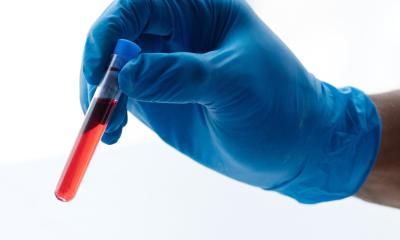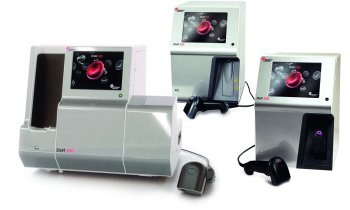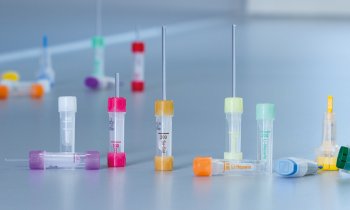
Source: Shutterstock/angellodeco
Article • Hematology
Recommendations on venous blood sampling
Pre-analytics, in particular venous blood sampling has a major impact on the quality of laboratory diagnostic results. An estimated 75 percent of all "lab errors" are caused by errors during pre-analytics. Thus, the German Medical Association’s national guideline on laboratory diagnostics includes detailed guidance on pre-analytics, in particular venous blood sampling.
In their current publication, Joint EFLM-COLABIOCLI Recommendation for venous blood sampling, the Working Group on Pre-analytics (WG-PRE and WG-PRE-LATAM) of the European Federation of Clinical Chemistry and Laboratory Medicine (EFLM) and the Latin America Confederation of Clinical Biochemistry (COLABIOCLI) present data on venous blood sampling and individually assess their impact on errors in the results. Twenty discrete steps are described and recommendations are presented in six grades, from 1A (strong recommendation with high quality evidence) to 2C (weak recommendation with low quality evidence – see table).
Pre-sampling
Initial pre-sampling communication with the patient is considered an important recommendation with low quality evidence (grade 1C). Correct patient identification is particularly important. Many laboratory parameters, e.g. proteins, can be strongly affected by the patient’s position during sampling. Therefore, the patient should ideally not change his/her position within 15 minutes prior to blood sampling. While this usually is not an issue with hospitalized, bedridden patients, for outpatient sampling, which is mostly done with the patient in a sitting position, this might be important. All blood tests should be drawn in the morning (between 7 and 9 am) in a fasting state, 12 hours after the last meal. Moreover, consumption of alcohol and caffeine-containing beverages, cigarette smoking and chewing gum within 24 hours prior to blood sampling can significantly affect the parameters to be analysed. These are strong recommendations with moderate quality evidence. Specific issues, such as drug monitoring, follow separate guidelines.
All supplies, devices and equipment required for blood sampling should be available, their presence being verified by the person performing the sampling. This is a grade 2C recommen dation – weak recommendation, low quality evidence. Correct labelling of the tubes, however, is considered a 1C recommendation – strong recommendation, low quality evidence.
Sampling

The same grade, 1C, is accorded to the wearing of gloves during the actual sampling procedure. Applying a tourniquet is a strong recommendation with high quality evidence (1A). Selection of the adequate venepuncture site requires precise anatomical knowledge on the course of the arm veins. The authors consider this a strong recommendation with moderate quality evidence (1B). Equally important, according to the authors, is thorough cleansing of the venepuncture site with 70 percent ethyl alcohol or any other appropriate disinfectant prior to sampling.
Alcohol drying times and handling of the disinfected site are described in detail. The next steps, puncturing the vein either with the needle or a butterfly, drawing the blood into the first tube and releasing the tourniquet are strong recommendations with high quality evidence (1A). The authors, moreover, consider the order of draw of utmost importance: blood culture tube, citrate tube, plain tube or tube with clot activator, heparin tube, EDTA tube, glycolysis inhibitor tube (NaF or comparable) and other tubes. Another strong recommendation is inversion, 5 to 10 times, of the correctly filled sample tubes. Gentle removal of the needle and correct disposal in adequate containers is a strong recommendation with high quality evidence (1A).
Subsequent treatment of the wound and asking the patient to apply pressure on the puncture site are strong recommendations with low quality evidence (1C).The tubes are inverted four more times, the gloves are removed and discarded. Correct removal of the gloves is considered a strong recommendation with high quality evidence.
Post sampling
After sampling, the patient should be advised to rest for about five minutes or he/she should be monitored by the person who took the sample until the bleeding has stopped. Communication with the patient that concludes the procedure is, according to the authors, a strong recommendation with moderate quality evidence. In a final section the authors discuss the implementation of the guidelines. Here, national laws and regulations which might pose an implementation barrier or challenge have to be considered. In order to successfully implement these guidelines on correct and error-free venous blood sampling a number of measures need to be taken. Staff has to be trained and refresher training has to be offered in regular intervals. Certification and regular recertification of the training as well as the actual performance of the procedure is useful. In the meantime audits are a suitable instrument to ensure long-term quality.
For hospitals, the authors recommend an implementation team with a team leader who is familiar with all national laws, regulations and recommendations and applies them resp. complies with them in the course of the implementation of the „Recommendations on venous blood sampling“.
Venous blood sampling — the sequence of steps
| Step | Strength of evidence |
|---|---|
| 1. Identify the patient | 1C |
| 2. Verify patient is fasting and properly prepared | 1B |
| 3. Obtain supplies required for blood collection | 2C |
| 4. Label/identify tubes | 1C |
| 5. Put on gloves | 1C |
| 6. Apply tourniquet | 1A |
| 7. Select venipuncture site | 1B |
| 8. Clean sampling site | 1B |
| 9. Puncture the vein | 1A |
| 10. Draw first tube | 1A |
| 11. Release the tourniquet | 1A |
| 12. Gently invert the tube once (one full inversion) | 1B |
| 13. Draw additional tubes following order of draw | 1B |
| 14. Remove needle from the vein and activate safety feature | 1A |
| 15. Dispose of the needle | 1A |
| 16. Bandage the puncture site | 1C |
| 17. Tell the patient to apply a gentle pressure for 5-10 min and not to bend the arm | 1C |
| 18. Invert all tubes 4 times | 1B |
| 19. Remove gloves | - |
| 20. Advise patient to rest for 5 min and ensure bleeding has stopped before leaving the site of venous blood collection | 1B |
Glossary
1A: strong recommendation, high quality evidence (benefits clearly outweigh risk and burdens or vice versa)
1B: strong recommendation, moderate quality evidence (benefits clearly outweigh risk and burdens or vice versa)
1C: strong recommendation, low quality evidence (benefits appear to outweigh risk and burdens or vice versa)
2A: weak recommendation, high quality evidence (benefits closely balanced with risks and burdens)
2B: weak recommendation, moderate quality evidence (benefits closely balanced with risk and burdens, some uncertainties in the estimates of benefits, risk and/or burdens)
2C: weak recommendation, low quality evidence (uncertainty in the estimates of benefits, risks and/or burdens; benefits may be closely balanced with risk and burdens)
Source: https://www.uptodate.com/home/grading-guide#GradingRecommendations

The original publication, further relevant publications and material to support implementation (poster, presentation, video) can be found on the Working Group‘s resource/educational material page.
Profile:
Prof Dr Dr Norbert Gässler is Director of the Centre of Laboratory Diagnostics at St. Bernward Hospital in Hildesheim, Germany, and POCT specialist. He is also an EFLM-certified European Specialist in Laboratory Medicine. Professor Gässler is a member of many professional associations, inter alia the American Association for Clinical Chemistry (AACC), the Professional Association of Scientists in Laboratory Diagnostics (Berufsvereinigung der Naturwissenschaftler in der Labordiagnostik – BNLD) and the German Society of Clinical Chemistry (Deutsche Gesellschaft für Klinische Chemie und Laboratoriumsmedizin – DGKL). He moreover authored and co-authored a number of clinical studies on POCT.
02.09.2018











